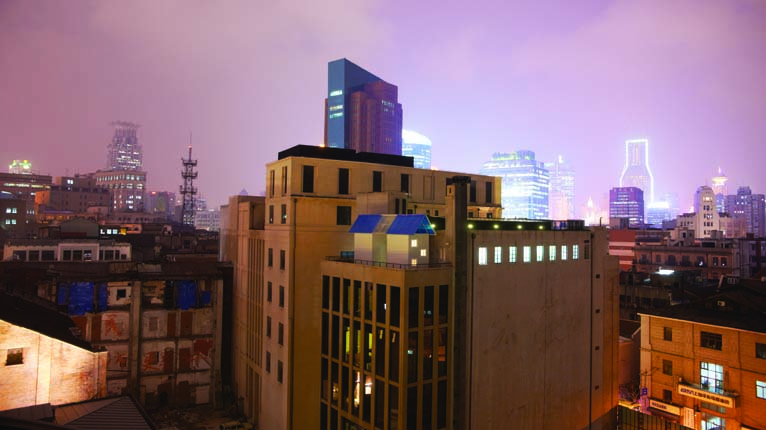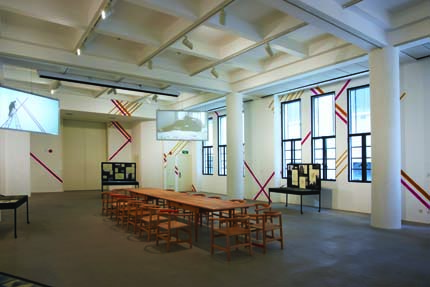COLLABORATION: MICHAEL LIN’S MODEL HOME
| July 5, 2012 | Post In LEAP 15

In Michael Lin’s work there is a consistent allusion to the relationship between people and their environment. The departure point is in his observation and intuition towards a particular setting. Gradually the works initiate a dialogue at the conjunction between the institutionalization of art spaces and the environments of the “everyday.” So what does this process actually entail? From start to finish, the answer is one word: collaboration.
Established from a position developed over 20 years, Lin’s Model Home is an exemplary use of collaboration. From the opening visual elements of the posters and invitations, every aspect of the design is utilized to convey intention. The background reveals a photograph depicting a construction worker perched on a scaffolding frame. The text interweaved in the foreground reveals a dense row of names listing the participants including curators, artists, and those involved in the drawing. Also listed amongst the names are construction workers, master chair-makers, the cook at the cafeteria, as well as Atelier Bow-Wow architects, the video artist Cheng Ran, the musician Lou Nanli, and the urban-planning researcher Li Xiangning. In past installations, Lin has applied his iconic patterns into “platforms” that naturally embed themselves into their environment— tatami mats, skateboard surfaces, and carpets— to invite audiences to enter the work. Viewing the contexts surrounding the artist’s work, the conjunction between “work” and the “art space” transforms into an interface where social and cultural interactions emerge.
Undoubtedly with the making of Model Home, the formulation of work and preparing the exhibition are combined into the same production process. That is to say, the art process is transformed into an interface of production, which frames an interaction between people from different fields. Forming another part of the display is a “temporary shelter” designed by Michael Lin and Atelier Bow-Wow according to the concept of “open function,” which is also used by workers as a place to live and work. Therefore, if Model Home is situated within the context of recent social movements and Lin’s analysis of Soviet avant-garde art, there appears to be an almost “communist” practice working at the heart of the fine art museum. Even if it does not precipitate the swift rise of a scathing revolution, the work nevertheless raises in abundance a profound space for reflection and antagonism.
The most compelling aspect of the work’s creative process is the decision to invite construction workers to fabricate the entire wall drawing. There is a painterly dimension to Michael Lin’s conceptual work. His appropriated patterns are reproduced and enlarged into a final work to resemble something between a decoration and a screen. In this piece, by deciding to involve construction workers rather than art students in his wall pattern drawings, the sensibilities of painting are scaled back in favor of a stronger emphasis on accidents. The effect manages to elude the feeling of an untrained novice, but it also fails to conjure the warm tactile sense of the artisan’s hand. Crucially, the flaws and imperfections open a passage for viewers to face the resultant drawing as an ontological site defined by craftsmanship. There is a similar situation found in traditional Japanese Raku pottery, which has deeply inspired the work of Lin. The crude surfaces of these containers and the imperfection in the final glaze, instead of turning into distasteful objects, actually encourage an appreciation of the scorched qualities of nature.

In another piece characteristic of Michael Lin’s oeuvre, Workers’ Club takes a frequently found cloth pattern and applies it onto the external walls. Similarly to the examples outlined earlier, the artist has again constructed a platform that situates itself naturally within an environment. Surrounding a central table are chairs with several exhibition blackboards positioned around the periphery. The phrase “gathering space” is inscribed on the blackboards in reference to a site of the same name designed by Alexander Rodchenko at the Workers’ Club for the 1925 Paris World Expo, as part of the Soviet Pavilion. Like a designer, Lin employs furniture manufacturers to produce the chairs by hand— in this case transforming a classic chair model designed by Hans J. Wegner. The chairs will be used to hold a series of academic lectures and public education projects hosted daily by the art museum. It is worth noting that the Y Chair created by Wegner is emblematic of a series of modernist approaches towards chair design. Wegner spent many years researching the design, but following commercialization, his tables and chairs eventually became associated with the “bourgeoisie.” For Michael Lin’s twenty-first-century realization of the Workers’ Club Chair, he combines the finely crafted joint-work of Chinese furniture makers with an application of color employed by the twentieth-century Soviet avant-garde movement. Intertwining through an expansive history of art, craft and design— meaning and form inadvertently travel across different variables and encounter with earlier contexts.
Model Home is Michael Lin’s most ambitious solo exhibition in recent years. The concept for the artist’s entire exhibition is treated using the same methods to produce a “mix-tape.” The work of the artist is to select pieces of different music to reconfigure and “remix” into a new soundtrack. Through the shared production of “amateurs” and “experts” operating in different fields, Lin scrutinizes the mode of artistic production within an art museum by challenging the capacity for accepted relations of production. (Translated by Billy Tang)


